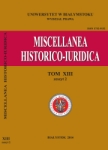Osoba najbliższa w polskich kodeksach karnych
Closest family member in Polish penal codes
Author(s): Cezary WiśniewskiSubject(s): Law, Constitution, Jurisprudence, Criminal Law, Family and social welfare, Penal Policy
Published by: Wydawnictwo Uniwersytetu w Białymstoku
Keywords: Polish criminal law; kinship; domestic partnership; concubinage; household;
Summary/Abstract: In Polish penal law the term “closest family member” has existed for decades. Since 1932, however, the circle of people encapsulated by that term has changed significantly. This article tracks those changes from the Polish Penal code of 1932 through to the revised Penal Code of 1969 and on up to 1997. In the Code of 1932, “closest family member” was defined as people connected to an individual by way of marriage, cognition or affinity. In the Code of 1969, this was expanded to incorporate adopted family members and their spouses, as well as a person with whom the individual lived in cohabitation. From the outset, this latter category generated issues relating to the status of adjudication of a cohabitating partner. Contemporarily, primary discussion revolves around homosexual couples. From the analysis of judicial decision and doctrine, it is clear that views in this respect remain divided. However, there is evidence that articulates greater appreciation that homosexual couples can be acknowledged as immediate family. Not withstanding, doctrine and judicial decision is not unitary.
Journal: Miscellanea Historico-Iuridica
- Issue Year: 13/2014
- Issue No: 2(2)
- Page Range: 241-252
- Page Count: 12
- Language: Polish

